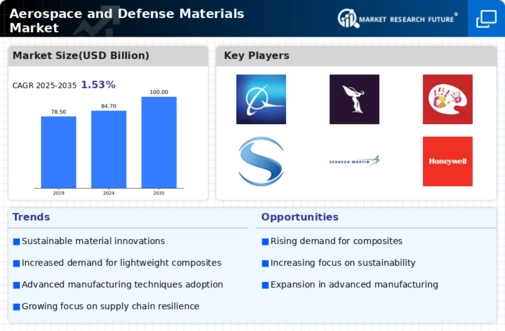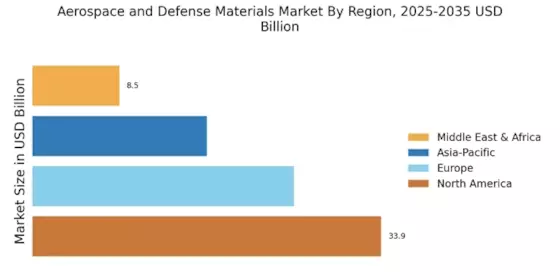Increased Defense Budgets
The Aerospace and Defense Materials Market is experiencing a notable surge in defense budgets across various nations. Governments are prioritizing national security, leading to increased investments in military capabilities. For instance, defense spending is projected to reach approximately 2 trillion USD by 2026, reflecting a compound annual growth rate of around 3.5%. This financial commitment necessitates the procurement of advanced materials that enhance the performance and durability of defense systems. Consequently, manufacturers are focusing on developing lightweight, high-strength materials that can withstand extreme conditions, thereby driving innovation within the Aerospace and Defense Materials Market.
Rising Focus on Cybersecurity
The Aerospace and Defense Materials Market is increasingly influenced by the rising focus on cybersecurity. As defense systems become more interconnected, the need for secure materials that can withstand cyber threats is paramount. This trend is prompting manufacturers to develop materials that not only meet physical performance standards but also incorporate cybersecurity features. The integration of secure materials is expected to become a critical factor in the design and production of aerospace and defense systems. Consequently, this focus on cybersecurity is likely to drive innovation and investment within the Aerospace and Defense Materials Market, as companies seek to address emerging threats.
Growing Demand for Lightweight Materials
The Aerospace and Defense Materials Market is witnessing a growing demand for lightweight materials, driven by the need for fuel efficiency and enhanced performance. The aviation sector, in particular, is increasingly adopting composite materials, which can reduce aircraft weight by up to 20%. This shift not only improves fuel economy but also reduces emissions, aligning with environmental regulations. As a result, manufacturers are investing in research and development to create advanced composites and alloys that meet the stringent requirements of the Aerospace and Defense Materials Market. The trend towards lightweight materials is expected to continue, influencing material selection in future aerospace projects.
Technological Innovations in Manufacturing
Technological innovations are reshaping the Aerospace and Defense Materials Market, particularly in manufacturing processes. Advanced techniques such as additive manufacturing and automation are enabling the production of complex geometries and customized materials. For example, additive manufacturing is projected to account for a significant portion of the aerospace materials market, with an estimated growth rate of 25% over the next five years. These innovations not only enhance production efficiency but also reduce material waste, making the manufacturing process more sustainable. As companies adopt these technologies, the Aerospace and Defense Materials Market is likely to see a transformation in how materials are produced and utilized.
Emerging Markets and Defense Collaborations
Emerging markets are playing a pivotal role in shaping the Aerospace and Defense Materials Market. Countries with developing defense sectors are increasingly collaborating with established nations to enhance their military capabilities. This collaboration often involves technology transfer and joint ventures, leading to the development of new materials tailored to specific defense needs. For instance, partnerships between nations can result in the creation of advanced alloys and composites that meet unique operational requirements. As these collaborations expand, the Aerospace and Defense Materials Market is likely to experience growth driven by the demand for specialized materials that support diverse defense initiatives.


















Leave a Comment